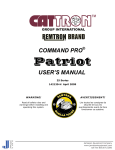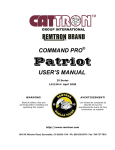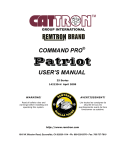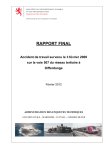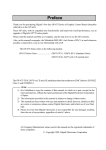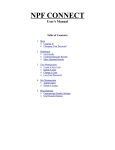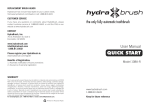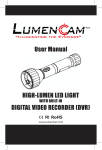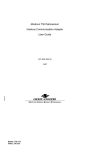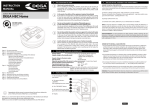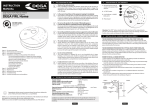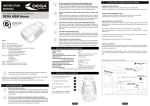Download Pump Boss II manual
Transcript
CATTRON GROUP INTERNATIONAL PUMP BOSS II ® RADIO CONTROL SYSTEMS USER’S MANUAL PBII Series Issue Number 1, May 2006 WARNING! AVERTISSEMENT! Read all safety rules and warnings before installing and operating this system. Lire toutes les consignes de sécurité et tous les avertissements avant de faire fonctionner ce systéme. http://www.remtron.com 1916 W. Mission Road, Escondido, CA 92029-1114 • Ph: 800-328-5570 • Fax: 760-737-7810 Issue Number 1, May 2006 PUMP BOSS II® USER’S MANUAL REMTRON, INC. PUMP BOSS II® RECEIVERS FCC COMPLIANCE STATEMENT PUMP BOSS II® series receivers have been tested and found to comply with the limits for a Class B digital device, pursuant to Part 15 of the FCC Rules. These limits are designed to provide reasonable protection against harmful interference in a residential installation. This equipment generates, uses, and can radiate radio-frequency energy, and if not installed and used in accordance with the user manual, may cause harmful interference to radio communications. However, there is no guarantee that harmful interference will not occur in a particular installation. If this equipment does cause harmful interference to radio or television reception, which can be determined by switching this equipment on and off, the user is encouraged to try to correct the interference by one or more of the following measures: • Reorient or relocate the receiving antenna that is connected to the device that is receiving the interference. • Increase the separation between our equipment and the equipment that is receiving the interference. • Consult our factory or one of our Service Representatives for additional help. Responsible Party: Remtron Inc. 1916 W. Mission Rd. Escondido, CA 92029 Phone: 800 328-5570 760 737-7800 Issue Number 1, May 2006 i PUMP BOSS II® USER’S MANUAL This page intentionally left blank ii Issue Number 1, May 2006 PUMP BOSS II® USER’S MANUAL TABLE OF CONTENTS SYSTEM DESCRIPTION ...................................................................................... 1 PBIIT Transmitter .............................................................................................. 2 PBIIR Receiver .................................................................................................. 4 INSTALLATION ................................................................................................... 6 Mechanical ........................................................................................................ 6 Antenna Installation ........................................................................................... 7 Locating the Antenna ......................................................................................... 7 RCA7 Long Range Antenna .............................................................................. 7 Installation Procedure ................................................................................... 7 Optional Antenna Mount ................................................................................... 9 Installation Procedure ................................................................................... 9 WIRING INSTRUCTIONS .................................................................................. 10 USING YOUR SYSTEM ..................................................................................... 15 Starting the System ........................................................................................... 15 Pump Operation ............................................................................................... 16 Helpful Hints ................................................................................................... 17 System Troubleshooting .................................................................................. 18 System Does Not Operate ........................................................................... 18 Insufficient Range ....................................................................................... 18 Transmitter Troubleshooting ....................................................................... 19 REPLACING THE BATTERIES .......................................................................... 20 REPLACING THE TRANSMITTER ................................................................... 21 AUTO LINK™ Procedure ................................................................................ 21 REPLACEMENT PARTS .................................................................................... 23 Pump Boss II® Spare Parts List ........................................................................ 23 WARRANTY STATEMENT ............................................................................... 24 Issue Number 1, May 2006 iii PUMP BOSS II® USER’S MANUAL LIST OF ILLUSTRATIONS Figure 1. PBIIT Transmitter .................................................................................. 3 Figure 2. PBIIR Receiver ....................................................................................... 4 Figure 3. RCA7 Antenna Mounting Template ....................................................... 8 Figure 4. Optional Antenna Mount ........................................................................ 9 Figure 5. Changing The Batteries ......................................................................... 20 Figure 6. AUTO LINK™ Switching ...................................................................... 22 iv Issue Number 1, May 2006 PUMP BOSS II® USER’S MANUAL SAFETY RULES WARNING! READ ALL INSTRUCTIONS Failure to follow these rules can result in serious personal injury. INSTALLATION • PROVIDE A SAFETY CUTOFF SWITCH. If maintenance is required, the radio must be disconnected from power to prevent accidental pump activation. • USE PROPER WIRING. Loose or frayed wires can cause accidental pump activation. • DO NOT INSTALL IN HOT AREAS. This apparatus can be damaged by heat in excess of 160° F. • DO NOT INSTALL IN HIGH VIBRATION AREAS. The life of this apparatus might be shortened through long exposure to intense shaking or vibration. PERSONAL SAFETY • MAKE SURE MACHINERY IS CLEAR BEFORE OPERATING. Do not activate the remote system unless it is safe to do so. • TURN OFF THE RECEIVER POWER BEFORE WORKING ON MACHINERY. Always disconnect the remote system power before doing any maintenance to prevent accidental operation of the machine. Issue Number 1, May 2006 v PUMP BOSS II® USER’S MANUAL This page intentionally left blank vi Issue Number 1, May 2006 PUMP BOSS II® USER’S MANUAL SYSTEM DESCRIPTION The Pump Boss II® system consists of a handheld transmitter, a pump mounted receiver, and antenna. When the operator presses a switch on the transmitter, a digital message is sent via radio waves to the receiver. The digital message contains one of millions of possible ID Codes. This unique code makes it possible for the receiver to respond only to the proper transmitter. Additional codes are also sent that make the chance of false commands less than 1 in 16 Million. The Pump Boss II® system incorporates a fail-safe ‘STOP’ feature in that a loss of radio signal will drop all relays in 5-seconds, thus shutting down the pump. When radio communications have been restored, the link to the receiver is restored and the user can command any function. During the loss of signal the receiver defaults to all functions off, and the user must restore any latching functions that were reset by loss of signal. All Pump Boss II® systems incorporate the innovative ‘AUTO LINK™’ function that allows the receiver to ‘learn’ the frequency channel and address of a replacement or spare transmitter. This function allows the Pump Operator to quickly substitute a spare PBIIT transmitter in the field without the need to physically reconfigure its frequency channel and address to match that of the receiver. Receiver Relays are Poly fused at 4.5-Amps. If too much current is drawn through these relays, the Poly fuse will open and remain open as long as electricity is applied through the relay. Once electricity is removed, the fuse will heal itself and be ready to operate in about 1-minute. NOTE In units that are operated above 24 VDC the relays are protected with a 7-Amp fuse. Such fuses can only be replaced at the REMTRON® factory. The Pump Boss II® system complies with the requirements for operation under Part 15 of the FCC rules and regulations. This means that neither the operator nor the company need apply or register for a license to operate this equipment. NOTE Any metallic objects will affect radio waves. As the result, difficulty operating in certain locations may be encountered. Read the section on using your system so that you can get the best performance from your system. Issue Number 1, May 2006 1 PUMP BOSS II® USER’S MANUAL PBIIT Transmitter Pump Boss II® transmitters are housed in a molded polymer plastic IP 67 compliant case, that stands up to extremely rugged use. A key feature is the REMTRON® patented switch assembly for control inputs. This long-life elastomeric keypad is ergonomically designed to provide easy operation over long periods of time with exceptional reliability. A leather holster provides added protection and convenience. An optional clear protective pouch is available from your dealer. Pump Boss II® transmitters are designed to be very efficient, operating from two AA batteries. To ensure long battery life, the transmitters will shut themselves off after one hour of inactivity. The antenna is internal to the transmitter case, protecting it from damage. A bi-colored self-test LED indicator provides a quick visual check of transmitter and battery status. This LED flashes GREEN when no problems are present, flashes RED and GREEN under low battery conditions, or SOLID RED when other problems are encountered. Referring to Figure 1 below, the Pump Boss II® Transmitter incorporates a POWER ‘ON’ Pushbutton, a ‘STOP/OFF’ Pushbutton, and a ‘PUMP/OFF’ 2-position Rocker Switch. Additional rocker switch functions are also provided, as follows: • ‘FWD/REV’ • THROTTLE ‘INCREASE/DECREASE’ • VOLUME ‘INCREASE/DECREASE’ NOTE 2 Depending on your exact system configuration, some or all of the additional rocker switch functions may not be operational. Issue Number 1, May 2006 PUMP BOSS II® USER’S MANUAL Figure 1. PBIIT Transmitter Issue Number 1, May 2006 3 PUMP BOSS II® USER’S MANUAL PBIIR Receiver Referring to Figure 2 below, Pump Boss II® Receivers are housed in a IP 67 Compliant, watertight molded polymer plastic case that stands up to extremely rugged use. Electrical connections to the receiver are made through a multi-conductor cable. The cable plug from the external antenna is connected to a TNC socket on the underside of the Receiver. The AUTO LINK™ Touch Pad switch allows the receiver to learn the ID code from a Remtron replacement transmitter. See the AUTO LINK™ section on page 21 of this manual for more information. Figure 2. PBIIR Receiver 4 Issue Number 1, May 2006 PUMP BOSS II® USER’S MANUAL PBIIR Receivers use an advanced synthesized FM receiver designed to work in the presence of potential interfering signals such as those that might be encountered from pagers, cell phones, two-way radios, etc. A microprocessor-based decoder ensures a great deal of safety as well as versatility. Commands are received on one of 81 possible frequencies and are both checked against a 16-bit address code for proper identity and further tested against a 16-bit CRC check code. This ensures that only valid information meant only for the particular unit is decoded. The receiver assembly monitors and indicates its status on a continuous basis. The diagnostics are presented in a simple, easy to understand format. The ‘POWER’ LED illuminates when power is applied to the receiver. The ‘SIGNAL’ LED has three functions: • It will double flash, pause and then repeat indicating the receiver is looking for a signal. • It will flash at a slow rate when receiving a signal, a faster rate when a command is received. • It will remain on with two short blink periods when the AUTO LINK™ switch is pressed on the receiver. After the receiver has learned the channel and address of the replacement transmitter, the LED will remain on solid without the two blinks. The ‘OUTPUT’ LED illuminates when the transmitter activates a command function (a receiver relay is activated). Issue Number 1, May 2006 5 PUMP BOSS II® USER’S MANUAL INSTALLATION NOTE Pump machines will vary between different manufacturers; therefore some wiring connections may be different from those provided in this manual. If you have questions about your installation, call Remtron Customer Service for assistance. Please have the Engineering Number (ENG #) beginning with 982 on the back of the transmitter label available when calling the factory. Product Wiring Configuration Sheets for the most common Pump Boss II® systems are provided on pages 11 thru 14 of this manual. WARNING! Do not install the receiver near exhaust pipes or in other hot areas. The Pump Boss II® system consists of: • • • • Handheld transmitter Leather transmitter holder and strap Receiver with attached multi-wire cable Antenna with coaxial cable Mechanical In selecting a place to mount the receiver consider the following points: • Access to the wiring for the control box on your machine. • Protection from mechanical damage during towing or during use. • Select a location with a flat mounting surface. • If possible, protect the receiver from direct exposure to sun and rain. Even though the receiver is weather resistant, it is good practice to protect it from the elements. Securely mount the receiver box to the pump using the supplied hardware. 6 Issue Number 1, May 2006 PUMP BOSS II® USER’S MANUAL Antenna Installation NOTE Proper antenna installation is essential for peak performance of the Pump Boss II®. Take care to install the antenna properly. Two different styles of antenna are available for Pump Boss II® systems. These must be permanently attached to the pump for proper performance. The standard Antenna supplied with the system is the RCA7 Long Range Antenna. An optional Antenna Mount is available that accepts a ‘whip’ style of antenna for short-range applications. Locating the Antenna For best reception, the antenna must be mounted to a horizontal surface with the top of the antenna at least 8-inches away from all major metal structures (vents, splash panel, exhaust, etc). There should be a clear line of sight between the antenna and the transmitter when pumping. The top of the pump hood is an excellent mounting location. To ensure trouble-free performance, the cable should be routed away from sources of heat such as the engine block, exhaust manifold, and exhaust pipe. The cable is rated for a maximum temperature of 185° F (85ºC). The cable must be secured in an out-of-the-way location where it will not be crushed or snagged. Before mounting the antenna, make sure the cable will reach the receiver box. RCA7 Long Range Antenna The RCA7 Long Range Antenna is mounted directly to the pump. The antenna mounting template is shown in Figure 3 below and may be photocopied for direct application to the mounting surface. Tools Needed: • • • • Drill or punch for 3/16 and 5/8-inch diameter holes #1 Phillips screwdriver Center punch Adhesive tape (such as masking tape) Installation Procedure 1. Tape the mounting hole template to the mounting surface. Locate the four hole centers on the mounting surface by punching through the paper template with the center punch. 2. Remove the template and drill the four holes as indicated on the template. Issue Number 1, May 2006 7 PUMP BOSS II® USER’S MANUAL Figure 3. RCA7 Antenna Mounting Template 3. Feed the antenna cable through the center (5/8-inch diameter) hole. Insert the rubber grommet in the hole to protect the cable from chafing. Two grommets are supplied on each cable to accommodate either a 5/8-inch diameter or a 3/4-inch diameter hole. Cut off the unused grommet. 4. Secure the antenna using the #6 hardware supplied. Insert the screws through the antenna and secure with the lock washers and nuts. 5. Route the cable to the receiver and secure with cable ties. 8 Issue Number 1, May 2006 PUMP BOSS II® USER’S MANUAL Optional Antenna Mount Tools Needed: • Drill or punch for 3/4-inch diameter hole This antenna mount accepts the whip type of antenna. Installation Procedure Referring to Figure 4 below: 1. Drill or punch a clean 3/4-inch diameter hole in the panel where the antenna will be mounted. Take care to make a smooth hole for the mounting surface. 2. Remove paint in a narrow ring around the underside of the hole. Note that metal-to- metal contact between the vehicle and the antenna mount will provide the best performance. If installation is on a fiberglass or other non-metallic surface, a minimum 10-inch diameter (or square) metal plate or foil must be placed under the mount to achieve proper performance from the antenna. Figure 4. Optional Antenna Mount 3. Using the small Allen wrench supplied with the mount, release the Allen screw within the insulator nut and unscrew the insulator nut from the antenna mount. Ensure the ‘O’ ring is present in its recessed location on the underside of the insulator nut. 4. From the underside of the panel, insert the antenna mount (with the center stud facing upwards) into the 3/4-inch diameter hole. From the top of the panel, screw the insulator nut, complete with ‘O’ ring, on to the exposed stud. Before finally tightening the insulator nut and Allen screw, ensure the antenna mount is centered within the 3/4-inch diameter hole and that the center stud does not contact any metal. 5. Route the cable to the receiver and secure with cable ties. Issue Number 1, May 2006 9 PUMP BOSS II® USER’S MANUAL WIRING INSTRUCTIONS All electrical connections are made from the receiver to the pump with the cable supplied with the Pump Boss II® system. NOTE Individual Pump Boss II® systems are provided with an Engineering Number (ENG #) which may be found on a label adhered to the back of the Transmitter. The same ENG # is also provided on the Wiring Configuration Sheet applicable to your product. Product Wiring Configuration Sheets for the most common Pump Boss II® systems are provided on pages 11 thru 14 of this manual. . Improper installation could cause damage to the pump and/or the Remtron control system. Qualified personnel should make all electrical installations. For safety, disconnect the input power before installing the Pump Boss II® radio control system. For applications involving throttle and/or volume, the PBIIR receiver utilizes an ‘H’ bridge output for motor control. This means that both sides of the motor are tied to ground when the motor is not being operated. In order to operate the actuator from a local front panel control, the PBIIR receiver must be disconnected from the motor actuator before power is applied from another source. This can be accomplished by using a transfer relay (local/ remote) or 3-throw toggle switch between the receiver from the local position actuator switch. This allows controlling of the actuator from your local position only when our receiver relay(s) is (are) disconnected from the actuator. 10 Issue Number 1, May 2006 PUMP BOSS II® USER’S MANUAL Issue Number 1, May 2006 11 PUMP BOSS II® USER’S MANUAL 12 Issue Number 1, May 2006 PUMP BOSS II® USER’S MANUAL Issue Number 1, May 2006 13 PUMP BOSS II® USER’S MANUAL 14 Issue Number 1, May 2006 PUMP BOSS II® USER’S MANUAL USING YOUR SYSTEM WARNING! Before operating the remote control system, make sure it is safe to do so. Make sure the same safety precautions normally required for safe pump operation are adhered to. DO NOT leave the transmitter unattended while the pump engine is operating. WARNING! Do not operate the system until you are familiar with the operation and safety procedures for the pump. IMPORTANT! To stop the system in an emergency, press and hold the red ‘STOP/OFF’ button to stop all functions. Place the ignition switch ON to power up the receiver. Verify the receiver ‘POWER’ LED is illuminated. If it is not, check the power connections to the receiver. NOTE The transmitter antenna is located inside the top of the transmitter case. Normal range should be achieved with the transmitter worn on your body. Moving the transmitter away from your body or holding it in the air can achieve extended range and operation in difficult areas. Pointing the transmitter towards the receiver will provide the greatest signal. Starting the System Press the transmitter ‘ON’ switch and observe that the bi-color transmitter LED flashes green. If the transmitter LED flashes red and then green, the batteries are low and should be replaced at the first opportunity. Note that when the red low battery condition is first observed, the operator has approximately 8-hours of operation left before the transmitter shuts down. Once the transmitter is switched on, if no switches are operated within 1-hour it will automatically switch itself off. Note that operation of any switch except the red ‘STOP/OFF’ switch will reset the 1-hour timer. Operating the transmitter’s ‘STOP/OFF’ switch will shut down the system. It should further be noted that when any other transmitter switch is pushed in conjunction with the ‘ON’ switch, the transmitter LED will illuminate solid red. This condition will prevent any operation of the pump. First pressing the transmitter’s red ‘STOP/OFF’ switch and then pressing the ‘ON’ switch will clear this condition. Issue Number 1, May 2006 15 PUMP BOSS II® USER’S MANUAL Pump Operation With the transmitter switched ON, pressing the top half of the ‘PUMP/OFF’ rocker switch starts the pump. Pressing the bottom half of the ‘PUMP/OFF’ rocker switch switches the pump OFF. Pressing the red ‘STOP/OFF’ switch will also shut off the pump and the transmitter. However, the ‘ON’ switch and the top half of the ‘PUMP/OFF’ rocker switch must be pressed in sequence to re-activate the pump. If the signal from the transmitter is lost for more than 5-seconds, the pump will shut off and the receiver will not recognize any commands from the transmitter. When the signal from the transmitter is restored, the top half of the ‘PUMP/OFF’ rocker switch must be depressed to start the pump before remote control can resume. On all PUMP BOSS II transmitters, several optional rocker switches are provided. These rocker switches operate in the same manner as the ‘PUMP/OFF’ rocker except they may be either (M) momentary or (L) latching. Consult the Configuration sheets on Pages 11 thru 14 and match the Engineering Number (982XXX) on the back of your transmitter to the Configuration sheet with the same number for the type and switch functions of your unit. NOTE 16 Depending on your exact system configuration, some or all of these optional rocker switch functions may not be operational. Issue Number 1, May 2006 PUMP BOSS II® USER’S MANUAL Helpful Hints If the Pump Boss II® system does not operate properly, check the wiring. Always make sure the electrical connections are clean and tight. Pumps vibrate, and loose wires can easily become disconnected. It is also a good idea to tie the wires from the receiver to solid points to keep them from swaying. Pump Boss II® receivers use self-healing 4.5-Amp Poly fuses to protect all Relays. If any of these receiver relays is overloaded, the fuse device will open to protect the unit. When it cools down, the device will close, restoring normal operation to the output. NOTE In units that are operated above 24 VDC the relays are protected with a 7-Amp fuse. Such fuses can only be replaced at the REMTRON® factory. Issue Number 1, May 2006 17 PUMP BOSS II® USER’S MANUAL System Troubleshooting System Does Not Operate 1. Check the transmitter (see Transmitter Troubleshooting on the next page). 2. Make sure the receiver ‘POWER’ LED is illuminated. If it is not lit, determine if +12 VDC is present between the red and black wires of the receiver. 3. Check that the receiver ‘SIGNAL’ LED illuminates when the transmitter is turned on. If it does not illuminate, the transmitter may not have ‘learned’ the transmitter’s frequency channel and address. Invoke the ‘AUTO LINK™’ procedure on the receiver and transmitter – refer to the AUTO LINK™ Procedure on Page 21. 4. See if the receiver ‘OUTPUT’ LED illuminates when the transmitter is used to switch on a function (a receiver relay is activated). If the LED indicates the signal from the transmitter was received, the problem is usually external to the receiver. Insufficient Range 1. Check that the receiver antenna is installed properly; see pages 8 and 9 of this manual. 2. Visually inspect connector, connector center pin, and cable for damage. Cable should have no cuts, kinks, or sharp bends, and will not stand temperatures above 185 degrees F (85ºC). If overheated, the cable will be stiff or flattened. Look for this in areas where the antenna cable is routed near the engine exhaust system. 18 Issue Number 1, May 2006 PUMP BOSS II® USER’S MANUAL Transmitter Troubleshooting The transmitters have a bi-colored LED status indicator to aid in troubleshooting. Due to the rough treatment it may be subjected to, most problems are likely to occur in the transmitter. The transmitter should be thoroughly diagnosed before proceeding to the receiver. WARNING! When testing the transmitter, the receiver may become active, resulting in system operation. Always assume the system is working and will respond when testing a transmitter. Transmitter Troubleshooting Chart LED Indication Possible Cause Remedy LED is off Transmitter is off Batteries are dead Transmitter Failure Press ‘ON’ switch Replace Batteries Call for service LED Alternating RED/GREEN Batteries getting low Batteries should be changed at the next convenient opportunity LED red on continuously Switch activated with ‘START’ Transmitter Failure Issue Number 1, May 2006 Activate ‘STOP’ switch then release ‘STOP’ switch. Activate ‘START’ switch without touching any other switch Call for service. 19 PUMP BOSS II® USER’S MANUAL REPLACING THE BATTERIES When the batteries are getting very low, the transmitter’s bi-colored self-test LED indicator will alternately flash between GREEN and RED. When this occurs, or at least every year, replace the transmitter batteries. AA Alkaline batteries should be used for long battery life. Rechargeable batteries are not recommended. Referring to Figure 5 below: 1. Fully release the two captive screws and remove the battery door. 2. Remove and replace the AA Alkaline batteries. Be sure to observe the correct polarity. 3. Replace the battery door and secure using the two captive screws. The battery door screws should be tightened until snug, plus half a turn. Figure 5. Changing the Batteries 20 Issue Number 1, May 2006 PUMP BOSS II® USER’S MANUAL REPLACING THE TRANSMITTER All Pump Boss II® systems incorporate the innovative ‘AUTO LINK™’ function that allows the receiver to ‘learn’ the frequency channel and address of a replacement or spare transmitter. This function allows the Pump Operator to substitute a spare PBIIT transmitter in the field without having to dismantle the transmitter or receiver to physically reconfigure its frequency channel and address. AUTO LINK™ Procedure Referring to Figure 6 below: 1. Install fresh batteries in the Transmitter and press the ‘ON’ switch. The green LED should flash. 2. Switch on the Radio Remote Receiver and check to see the ‘POWER’ LED is lit up. 3. Press and hold the receiver’s ‘AUTO LINK™’ Touch Pad (switch) and observe that the ‘SIGNAL’ LED lights up with two short blinks. 4. Locate the transmitter within 5-feet of the receiver antenna. Press and hold the transmitter’s red ‘STOP/OFF’ button switch and observe the receiver’s ‘SIGNAL’ LED. When the ‘SIGNAL’ LED is continuously lit (no blinks), the receiver has ‘learned’ the frequency channel and address (ID Code) of the transmitter. NOTE If the receiver’s ‘SIGNAL’ LED does not switch from blink to solid, the old transmitter ID code will remain in receiver memory. 5. Release the receiver’s ‘AUTO LINK™’ switch, followed by the transmitter’s ‘STOP/OFF’ button switch. The replacement transmitter’s frequency channel and address is now entered in the receiver memory. You may now proceed with Pump Operation. Issue Number 1, May 2006 21 PUMP BOSS II® USER’S MANUAL Figure 6. AUTO LINK Switching 22 Issue Number 1, May 2006 PUMP BOSS II® USER’S MANUAL REPLACEMENT PARTS Replacement parts are available from the distributor where you purchased the system or directly from the Remtron factory. Pump Boss II® Spare Parts List Item Part # Leather holster 620022 Shoulder strap for transmitter 600008-02 Weather resistant, clear plastic carry bag for transmitter (shoulder strap not included) 620024 RCA7 900 MHz long range antenna (standard item supplied with system) 950185-01 900 MHz 12 coil whip antenna (no coax, 485022 no mount) 900 MHz antenna mount with coax (no antenna) Issue Number 1, May 2006 920053 23 PUMP BOSS II® USER’S MANUAL WARRANTY STATEMENT Pump Boss II® Concrete Pumping Products Period of Warranty: Remtron warrants the Pump Boss II® against malfunction or breakage for a period of one year from the date of purchase or one year from the date of the original invoice, if the warranty registration card is not received. Warranty Coverage: Pump Boss II® transmitters, receivers, and accessories, in normal and customary use, are conditionally warranted against malfunction or breakage. The warranty does not cover: (a) defects or damage resulting from use of the product in other than its normal and customary manner; (b) defects or damage from misuse, accident, or neglect; (c) defects from improper testing, operation, maintenance, installation, alteration, modification, or adjustment; (d) damage from unauthorized repair or alterations; and (e) damage from water or corrosive materials beyond the specification of the case or enclosure General Terms of Warranty: Remtron will repair or replace the defective unit, solely at our option in the event of defect or failure to perform as specified, provided the product is returned in accordance with the terms of this warranty. Replacement parts are covered for the balance of the original warranty. All costs of shipping to Remtron shall be borne by the purchaser. The warranty covers the cost of return one-way shipping and handling of the product. The return shipment will be via the same method as the product was shipped. This warranty does not cover the costs of outside repair service except as authorized by Remtron. If it is determined that a third party is necessary for the service or repair of the Remtron product, prior approval by Remtron is required. This warranty sets forth the full extent of Remtron’s responsibility regarding the product(s). Repair, replacement or refund of the purchase price, at Remtron’s option are the exclusive remedies. This warranty is given in lieu of all other express warranties. All other warranties, expressed or implied, including without limitation implied warranties of merchantability or fitness for a particular purpose, are specifically excluded. In no event shall Remtron be liable for damages in excess of the purchase price of the product(s), for any loss of use, loss of time, inconvenience, commercial loss, lost profits or savings or other incidental, special or consequential damages arising out of the installation, use or inability to use the product(s), to the full extent that such may be disclaimed by law. 24 Issue Number 1, May 2006 PUMP BOSS II® USER’S MANUAL How to Get Service: Products returned for repair (warranty or non-warranty) must be assigned an RMA (Return Material Authorization) number by a Remtron Customer Service representative. To allow us to more effectively address the repair issues, the customer is to provide a detailed description of the specific problem. Call 800-328-5570 for service or RMA assignment. To receive warranty service, deliver or send the product(s) along with the assigned RMA number to our factory. All repairs are performed at the Remtron factory in Escondido, California. This ensures that all parts of the remote system are maintained to factory standards. Repairs are billed at a flat rate irrespective of time; however, external damage caused by misuse, accident, neglect, or damage to the case or other assembly components could incur additional costs. Please include your name, address, and a telephone number in case our repair technicians need more information from you. Enclosing a detailed description of the problem will allow us to give you better service. Issue Number 1, May 2006 25 PUMP BOSS II® USER’S MANUAL This page intentionally left blank 26 Issue Number 1, May 2006 PUMP BOSS II® USER’S MANUAL PBII Series Issue Number 1, May 2006




































